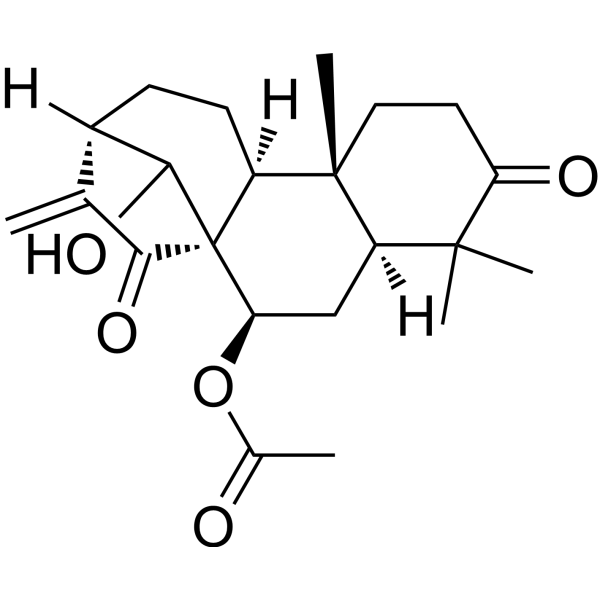Glaucocalyxin DCAS# 140671-02-9 |

Quality Control & MSDS
Package In Stock
Number of papers citing our products

| Cas No. | 140671-02-9 | SDF | Download SDF |
| PubChem ID | N/A | Appearance | Powder |
| Formula | C22H30O5 | M.Wt | 374.47 |
| Type of Compound | Diterpenoids | Storage | Desiccate at -20°C |
| Synonyms | (-)-Glaucocalyxin D | ||
| Solubility | Soluble in Chloroform,Dichloromethane,Ethyl Acetate,DMSO,Acetone,etc. | ||
| General tips | For obtaining a higher solubility , please warm the tube at 37 ℃ and shake it in the ultrasonic bath for a while.Stock solution can be stored below -20℃ for several months. We recommend that you prepare and use the solution on the same day. However, if the test schedule requires, the stock solutions can be prepared in advance, and the stock solution must be sealed and stored below -20℃. In general, the stock solution can be kept for several months. Before use, we recommend that you leave the vial at room temperature for at least an hour before opening it. |
||
| About Packaging | 1. The packaging of the product may be reversed during transportation, cause the high purity compounds to adhere to the neck or cap of the vial.Take the vail out of its packaging and shake gently until the compounds fall to the bottom of the vial. 2. For liquid products, please centrifuge at 500xg to gather the liquid to the bottom of the vial. 3. Try to avoid loss or contamination during the experiment. |
||
| Shipping Condition | Packaging according to customer requirements(5mg, 10mg, 20mg and more). Ship via FedEx, DHL, UPS, EMS or other couriers with RT, or blue ice upon request. | ||

Glaucocalyxin D Dilution Calculator

Glaucocalyxin D Molarity Calculator
| 1 mg | 5 mg | 10 mg | 20 mg | 25 mg | |
| 1 mM | 2.6704 mL | 13.3522 mL | 26.7044 mL | 53.4088 mL | 66.761 mL |
| 5 mM | 0.5341 mL | 2.6704 mL | 5.3409 mL | 10.6818 mL | 13.3522 mL |
| 10 mM | 0.267 mL | 1.3352 mL | 2.6704 mL | 5.3409 mL | 6.6761 mL |
| 50 mM | 0.0534 mL | 0.267 mL | 0.5341 mL | 1.0682 mL | 1.3352 mL |
| 100 mM | 0.0267 mL | 0.1335 mL | 0.267 mL | 0.5341 mL | 0.6676 mL |
| * Note: If you are in the process of experiment, it's necessary to make the dilution ratios of the samples. The dilution data above is only for reference. Normally, it's can get a better solubility within lower of Concentrations. | |||||

Calcutta University

University of Minnesota

University of Maryland School of Medicine

University of Illinois at Chicago

The Ohio State University

University of Zurich

Harvard University

Colorado State University

Auburn University

Yale University

Worcester Polytechnic Institute

Washington State University

Stanford University

University of Leipzig

Universidade da Beira Interior

The Institute of Cancer Research

Heidelberg University

University of Amsterdam

University of Auckland

TsingHua University

The University of Michigan

Miami University

DRURY University

Jilin University

Fudan University

Wuhan University

Sun Yat-sen University

Universite de Paris

Deemed University

Auckland University

The University of Tokyo

Korea University
- Bulnesol
Catalog No.:BCX1757
CAS No.:22451-73-6
- Inflexuside A
Catalog No.:BCX1756
CAS No.:1395048-85-7
- Cnidioside B
Catalog No.:BCX1755
CAS No.:141896-54-0
- Pseudobatigenin-7-O-β-D-xylopyranosyl(1→6)-β-D-glucopyranosid
Catalog No.:BCX1754
CAS No.:224957-15-7
- Ladanetin
Catalog No.:BCX1753
CAS No.:23130-22-5
- Salvifaricin
Catalog No.:BCX1752
CAS No.:87321-87-7
- (5S,6R,7R,8S)-2-(2-phenylethyl)-5,6,7-trihydroxy-5,6,7,8-tetrahydro-8-[2-(2-phenylethyl)chromonyl-6-...
Catalog No.:BCX1751
CAS No.:121795-56-0
- (-)-3,3'-Bisdemethylpinoresinol
Catalog No.:BCX1750
CAS No.:340167-81-9
- Chavicol 1-O-β-D-glucopyranoside
Catalog No.:BCX1749
CAS No.:64703-98-6
- Tanegoside A
Catalog No.:BCX1748
CAS No.:131653-21-9
- Oxyresveratrol 4'-O-β-D-glucopyranoside
Catalog No.:BCX1747
CAS No.:863329-68-4
- Peucedanol
Catalog No.:BCX1746
CAS No.:46992-81-8
- Salviandulin E
Catalog No.:BCX1759
CAS No.:158994-32-2
- Quercetin-3-O-(2''-O-galloyl)-β-D-glucopyranoside
Catalog No.:BCX1760
CAS No.:69624-79-9
- Inflexuside B
Catalog No.:BCX1761
CAS No.:1395048-86-8
- Irisquinone
Catalog No.:BCX1762
CAS No.:56495-82-0
- 2-Methoxy-6-pentadecyl-1,4-benzoquinone
Catalog No.:BCX1763
CAS No.:144078-11-5
- 2,4-Dihydroxy-allylbenzene-2-O-β-D-glucopyranoside
Catalog No.:BCX1764
CAS No.:1416564-61-8
- Polyfuroside
Catalog No.:BCX1765
CAS No.:108886-03-9
- Donasine
Catalog No.:BCX1766
CAS No.:1017237-81-8
- Poricoic acid H
Catalog No.:BCX1767
CAS No.:415724-85-5
- Dugesin C
Catalog No.:BCX1768
CAS No.:1403505-97-4
- Salvileucantholide
Catalog No.:BCX1769
CAS No.:158994-33-3
- (7R,8S,8′R)-4,7-Dihydroxy-3,3′,4′-trimethoxyl-9-oxo dibenzylbutyrolactone lignan-4-O-β-D-glucopyrano...
Catalog No.:BCX1770
CAS No.:1807808-90-7
[Chemical constituents of Rabdosia japonica var. glaucocalyx and their anti-complementary activity].[Pubmed:23672041]
Zhongguo Zhong Yao Za Zhi. 2013 Jan;38(2):199-203.
To study the chemical constituents of Rabdosia japonica var. glaucocalyx and their anti-complementary activity on the basis of preliminary studies. Target isolation guided by anti-complementary activity test, compounds in the chloroform and n-butanol fractions were isolated and purified by silica gel and Sephadex LH-20 column chromatographies, and preparative HPLC. The structures were identified by various spectroscopic data including ESI-MS, 1H-NMR and 13C-NMR data. The compounds were evaluated for anti-complementary activity in vitro. Eleven compounds were isolated from the chloroform and n-butanol soluble fractions and identified as stigmasterol (1), stigmas-9 (11) -en-3-ol (2), Glaucocalyxin D (3), kamebakaurin (4), maslinic acid (5), corosolic acid (6), minheryins I (7), diosmetin (8), caffeic acid ethylene ester (9), caffeic acid (10) and vitexin (11). Isoquercetrin, rutin, quercetin, 3-methylquercetin, luteolin, 7-methylluteolin, and apigenin which were isolated from the preliminary studies together with compounds 9 and 10 showed inhibition of the complement system by the classical pathway. Compounds 2, 4, 6-9 and 11 were obtained from this plant for the first time. Caffeic acid (10) showed the strongest activity in vitro with a CH50 value of 0.041 g x L(-1).


